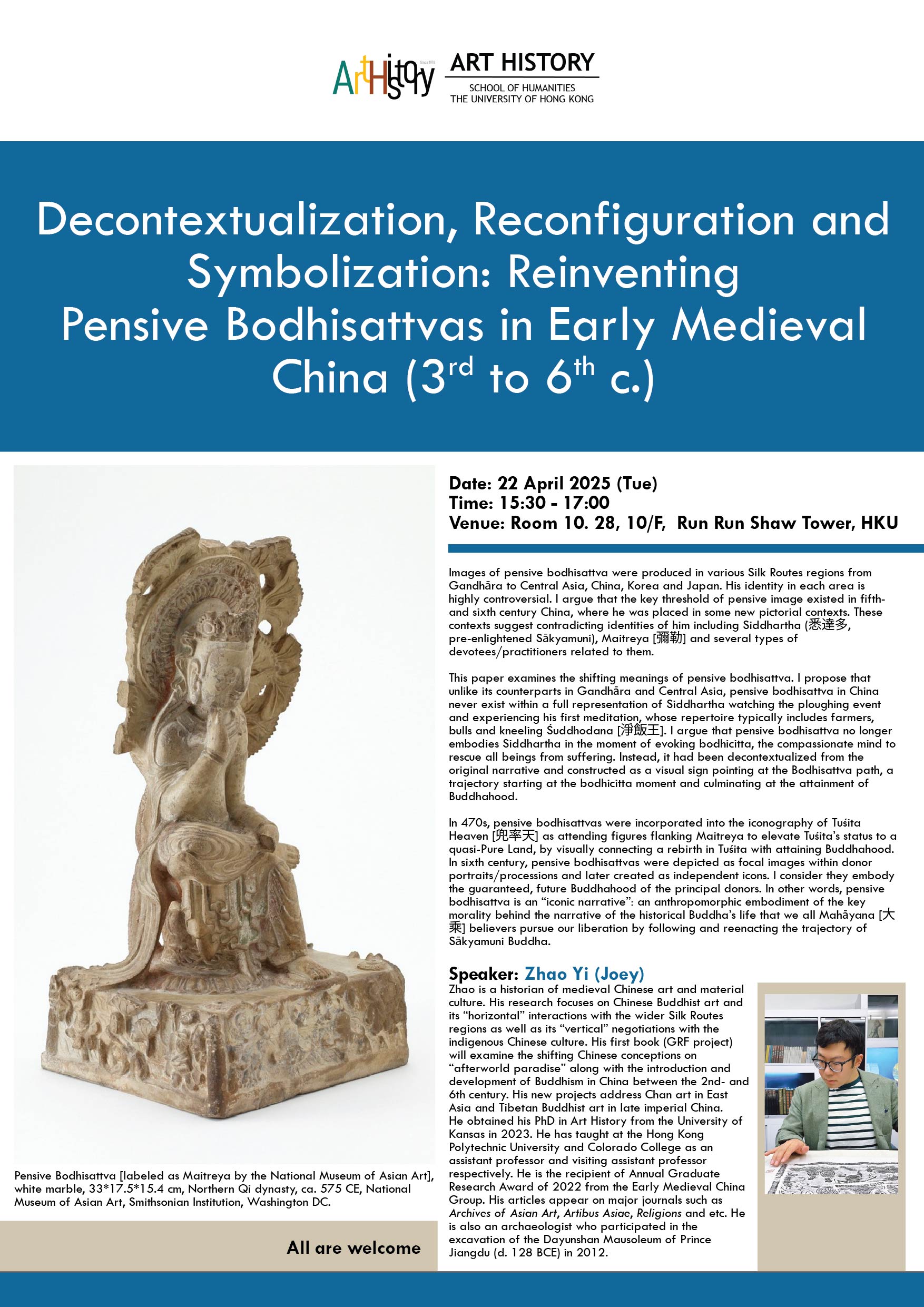

Decontextualization, Reconfiguration and Symbolization
April 22 @ 3:30 pm - 5:00 pm
Decontextualization, Reconfiguration and Symbolization: Reinventing Pensive Bodhisattvas in Early Medieval China (3rd to 6th c.)
Images of pensive bodhisattva were produced in various Silk Routes regions from Gandhāra to Central Asia, China, Korea and Japan. His identity in each area is highly controversial. I argue that the key threshold of pensive image existed in fifth- and sixth century China, where he was placed in some new pictorial contexts. These contexts suggest contradicting identities of him including Siddhartha (悉達多, pre-enlightened Sākyamuni), Maitreya [彌勒] and several types of devotees/practitioners related to them.
This paper examines the shifting meanings of pensive bodhisattva. I propose that unlike its counterparts in Gandhāra and Central Asia, pensive bodhisattva in China never exist within a full representation of Siddhartha watching the ploughing event and experiencing his first meditation, whose repertoire typically includes farmers, bulls and kneeling Śuddhodana [淨飯王]. I argue that pensive bodhisattva no longer embodies Siddhartha in the moment of evoking bodhicitta, the compassionate mind to rescue all beings from suffering. Instead, it had been decontextualized from the original narrative and constructed as a visual sign pointing at the Bodhisattva path, a trajectory starting at the bodhicitta moment and culminating at the attainment of Buddhahood.
In 470s, pensive bodhisattvas were incorporated into the iconography of Tuśita Heaven [兜率天] as attending figures flanking Maitreya to elevate Tuśita’s status to a quasi-Pure Land, by visually connecting a rebirth in Tuśita with attaining Buddhahood. In sixth century, pensive bodhisattvas were depicted as focal images within donor portraits/processions and later created as independent icons. I consider they embody the guaranteed, future Buddhahood of the principal donors. In other words, pensive bodhisattva is an “iconic narrative”: an anthropomorphic embodiment of the key morality behind the narrative of the historical Buddha’s life that we all Mahāyana [大乘] believers pursue our liberation by following and reenacting the trajectory of Sākyamuni Buddha.
Date: 22nd April 2025 (Tuesday)
Time: 3:30-5pm
Venue: Room 10.28, 10/f, Run Run Shaw Tower, HKU
Free seating
Speaker: Zhao Yi (Joey)
Zhao Yi (Joey) is a historian of medieval Chinese art and material culture. His research focuses on Chinese Buddhist art and its “horizontal” interactions with the wider Silk Routes regions as well as its “vertical” negotiations with the indigenous Chinese culture. His first book (GRF project) will examine the shifting Chinese conceptions on “afterworld paradise” along with the introduction and development of Buddhism in China between the 2nd- and 6th century. His new projects address Chan art in East Asia and Tibetan Buddhist art in late imperial China.
He obtained his PhD in Art History from the University of Kansas in 2023. He has taught at the Hong Kong Polytechnic University and Colorado College as an assistant professor and visiting assistant professor respectively. He is the recipient of Annual Graduate Research Award of 2022 from the Early Medieval China Group. His articles appear on major journals such as Archives of Asian Art, Artibus Asiae, Religions and etc. He is also an archaeologist who participated in the excavation of the Dayunshan Mausoleum of Prince Jiangdu (d. 128 BCE) in 2012.



Find us on…